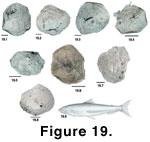 Description
DescriptionThaleichthys pacificus
(Eulachon)
(Other common names: Candlefish, Oilfish, Oulachon, Columbia River Smelt)
Figure 19.9
 Description
DescriptionLength: 23 cm.
Mouth: large, terminal, directed upwards; upper jaw extends to the posterior margin of orbit; teeth small, pointed and on both jaws (teeth may be lost in spawning individuals).
Body: long; operculum smooth with concentric striae; concentric striae present also on suboperculum; caudal peduncle compressed; dorsal fin originates behind mid-point of the body (behind pelvic insertion); adipose fin sickle shaped; four to six gill rakers on the upper part of the first gill arch; at spawning, males have numerous tubercles (projections) on head, body and upper sides of paired and anal rays; adipose fin on its back, near the tail; lateral line canal curves downwards anteriorly.
Color: upper is blue to blue-brown; sides and lower are silvery white.
Depth: pelagic.
Habitat: nearshore; coastal inlets and rivers.
Season: anadromous; three-year old adults spawn in early spring (February -mid-May); spawning is done in large aggregations and generally at night with external fertilization; eggs then sediment out of the water column attach to substrate for development.
Diet: crustaceans (e.g., copepod larvae, mysids, ostracods, euphasiids).
Predators: fish species (e.g., shark, flatfish, sturgeon), marine mammals, seabirds.
Distribution: northern California to the eastern Bering Sea and the Pribilof Islands.
 Scale
Description
Scale
DescriptionRelative Scale Size: small to moderate. The scales in the series are generally of similar size. This is a thin, somewhat fragile scale.
Position of Scales on Body: 70-78 scales in the lateral line canal (Hart, 1973).
Overall Scale Shape: circular with irregular outside edge.
Focus and Circuli: the focus is not centralized between the fields, it is approximately one-quarter of the way from the outside edge of the posterior field. It is difficult to demarcate the fields, but a good indicator is the posterior field; it is compressed and pigmented tissue may still be attached. The circuli are continuous between all fields, but are slightly more compacted in the posterior field.
Radii: absent.
To date, no eulachon scales have been found in Effingham sediments. This species is nearshore, but the primary migration route is through the Strait of Georgia, into the Fraser River to spawn. It is not known if this species uses the West Coast Vancouver Island inlets. The potential for preservation of scales seems low due to the thin and fragile nature of the scales.